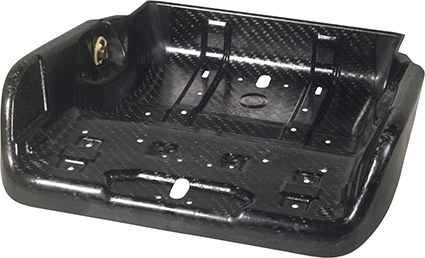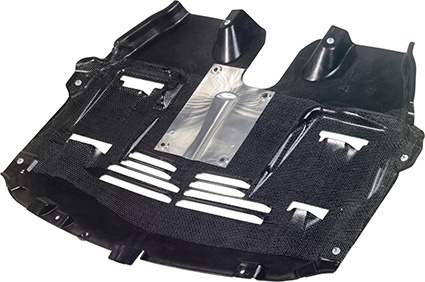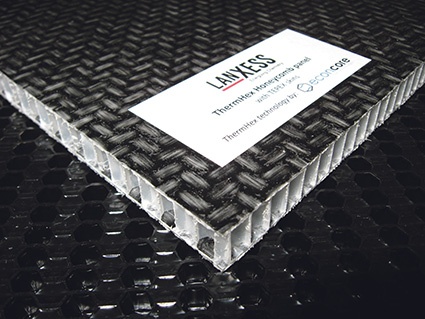A Perfect Symbiosis of Material and Design



Replacing sheet metal with Tepex dynalite continuous-fiber-reinforced thermoplastic composites delivers significant additional weight savings in numerous areas of plastic-metal composite technology (hybrid technology). As the latest series parts show, even thermoplastic compression molding processes benefit from the composite's potential in terms of lightweight materials and design.
Tepex is a high-tech product from Lanxess subsidiary Bond-Laminates, which is based in Brilon, Germany. The composites are reinforced with balanced or strong-chain continuous-fiber fabrics made from high-strength glass, aramid or carbon fibers, are fully impregnated and consolidated and are produced in consistently high quality for large-scale series production. When it comes to structural components for automobiles, polyamide 6, polyamide 66 and polypropylene are mainly used for the matrix, while continuous glass fiber rovings are usually used for reinforcement. The continuous fibers are decisive for the mechanical properties of the composites and are as long as the part itself. A force applied along the orientation of the fibers will flow from one point of force transmission to another mainly via the continuous fibers. As a result, the component is very rigid and strong along the orientation of the fibers.
Prototype of an Infotainment Carrier
At a density of just 1.4 - 1.8 kg/dm3, Tepex dynalite is lighter than aluminum and sheet steel (2.7 and 7.8 kg/dm3 respectively), and has advantages in terms of weight-specific strength and formability. It significantly boosts the potential for lightweight design using hybrid technology, as evidenced by a prototype of an infotainment carrier for use in a car interior. The prototype was developed for series production by Audi, Lanxess, KraussMaffei Technologies and Christian Karl Siebenwurst Modell- und Formenbau. The component has to hold an amplifier and optionally a TV tuner. It weighs almost only half as much as a comparable steel component, is easier to install and can be produced in a process that is suitable for large-scale series manufacturing. Tepex is used to reinforce the connection points with the bodywork and add-on parts, these being subjected to very high mechanical loads. It is entirely feasible that other supporting structures in the automobile - such as carriers for electrical and electronic modules in hybrid technology - could be made with Tepex.
Seat Shell in Series Production
Another example of the weight-saving potential of composite hybrid technology is the seat shell {Fig. 1} of the Opel Astra OPC (manufactured by Reinert Kunststofftechnik). It is approximately 800g or 45% lighter than the previous component design. It is produced using an in-mold forming technique in a one-shot process that combines the characteristic lightweight capabilities and material qualities of Tepex with a cost-effective production technique. A heated composite insert is placed in an injection mold and shaped and ribs made of polyamide 6 reinforced with short glass fibers are injection molded onto it directly.
Reinforced Composite Overlays for Compression Molded Parts
Tepex has a growing range of potential applications in compression molding for fiber-reinforced thermoplastic matrices. This process can be used as a cost-effective means of manufacturing large components in a customized material mix with short cycle times. What's more, low mold costs also enable production in small to medium production volumes. The incentive to use Tepex is that, when used as an overlay, it significantly reinforces specific areas of components that are exposed to particularly high loads. Tepex grades based on polypropylene or polyamide are used, which can be combined with various compression molding or forming materials, for instance with direct long-glass-fiber-reinforced thermoplastics (DLFT), glass-mat-reinforced thermoplastic systems (GMT) and low-weight-reinforced thermoplastics (LWRT). The result is a sandwich component that is many times more rigid and stronger than an equivalent without a Tepex overlay and can also absorb more crash energy.
A recent example of such a sandwich design is the engine compartment guard plate in the Mini John Cooper Works GP {Fig. 2}. During production of this component, a polypropylene-based DLFT mass that has been compounded with continuous glass fiber rovings is compressed with two Tepex dynalite overlays. The overlays give the part three times the strength and energy absorption of a solely polypropylene-based DLFT component. Compared to guard plates made of sheet steel or aluminum, this construction method delivers a weight saving of up to 50 and 20% respectively.
Outlook
Thermoplastic sandwich composites with a honeycomb core are a new approach in lightweight design. They promise further improvements in terms of specific strength, rigidity and weight savings. That is why Lanxess and EconCore, based in Leuven, Belgium, are collaborating on the development of honeycomb cores {Fig. 3}. The goal is to manufacture these cores from Durethan polyamides using the automated, continuous ThermHex honeycomb technology patented by EconCore. The polyamide honeycomb cores would then be covered with Tepex outer skins.







